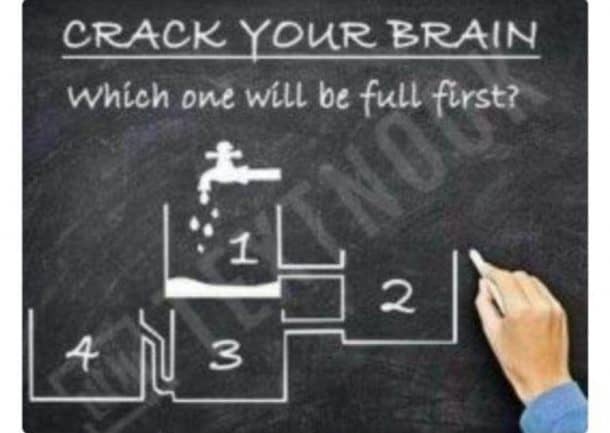
The picture you see above has had over 100 responses on Quora, but almost all of them have their own reasons, and none of them is fully sure of the answer. So we decided to have a crack at it ourselves.
As much as we want to make every question a simple black and white issue, it rarely ever is the case. And just one glance at the question makes it clear that the question is far more than just being solvable using intuition. The exact answer would indeed depend on the variables, conditions and other assumption about the conditions such as temperature, fluid properties, pressure, etc.
![[Image Courtesy of Nirav Adroja/Quora]](http://wonderfulengineering.com/wp-content/uploads/2016/10/tank-puzzle.jpg)
Coming to the next pots, 3 and 4 would fill up at the same time theoretically if we assume that all tanks and pipe connections are identical and the room conditions are constant and the fluid being used is, in fact, water. Low flow rates change that order with 3 filling first, then shortly followed by 4. However, with the lack of data, the differences between the heights of pots 1 and 2 as well as the clear angle of the connection between pots 3 and 4 leaves a lot to simplifying assumptions.
What is your verdict on this interesting problem? Comment below!



3 (4 STARTS FILLING LATE
No:3. (4 STARTS FILLING LATE. SO 3 WILL OVER FLOW FIRST AND FOLLOWEDBY 4)
It depends on your definition of ‘full’ which to me means full to the top and overflowing. This can only be achieved by Tank 4 as all the others will drain to the last tank. Tank 1 could only fill first if the flow from the tap was faster than the rate of draining into tank 2. I think we can discount that.
So dear people at normal flow the only tank that can be full to overflowing is tank 4, the last one in the sequence of downhill flow ?
I am a pipe fitter and this is based on hydraulic calculations. The important information that is not included is the “flow rate” of the water flow entering tank 1. If this is under “pressure” we have to ask ourselves is the “flow rate” (USGPM) entering tank 1 faster then the gravity flow rate entering tank 2. And by how fast? So potentially tank 1 could fill first before enough volume of water can create enough gravity pressure to increase the flow rate for enough water can fill tank 2. Do you see where I am going with this? There are many variables that can affect the outcome of this puzzle.
Without over analysing the question that is being asked, I very quickly came to the conclusion that tank 1 will be the first and only tank to overflow. (The reason I say “overflow” because the definition of “fill” has not been specified.) Of course tank 3 then 4 will fill at the same rate, but the outlet for tank 2 is drawn very distinctly to match the position of the inlet of tank 4. The tanks will begin to back fill each other. The water flow from the faucet will not be enough pressure to lift the water in tank 4, therefore causing a clog effect for 3 and 4 then 2. Once 2 fills to its inlet point it will too clog the outlet of tank 1 causing it to fill all the way until it over flows…
It depends on your definition of full. If by “full” you mean “to the brim” 3 will get to the point of its outlet first, then 4 will catch up to 3 and they will fill together. However if you define full as just to the the top of the outlet for 3, then it will fill first. If they were both covered then I would say 3 and 5 would reach the lid at the same time, provided they were the same size.
Pot 3 will fill up to the level of the its inlet. Water will then flow into pot 4 while the level of pot 3 remains constant. Once the level in pot 4 fills ups to the level of its inlet, pots 2, 3 and 4 will rise together for a short while until pots 3 and 4 begin to spill over. Assuming the flow rate is below a critical value, pots 3 and 4 will continue to overflow indefinitely, while the levels in pots 1 and 2 will never rise above the level of their respective outlets.
3 and 4 will fill at same time…and If both 3,4 containers are closed on top then 2 will filled up…then 1 will fill If 2 container is closed on top.
Pot 3 will fill first to the level of the overflow, then 3 and 4 will fill at the same time. Pot 1 and 2 will never fill, because 3 and 4 would flow over!! 8<)
3 will fill up first
Pot3 will be filled first as the water tends to go towards lower level once pot3 is filled it will automaticallly transfer water to pot4 and at the sametime will be refilled frm pot2 once pot4is filled& pot 3 is refilled the waterlevel in pot2 will rise and ultimately once pot2 is filled water in pot 1 will rise to the maximum level
Pot3
Pot4
Pot2
Pot1
Tank 3 will fill first shortly followed by Tank 4, after that Tank 2 and in last Tank 1